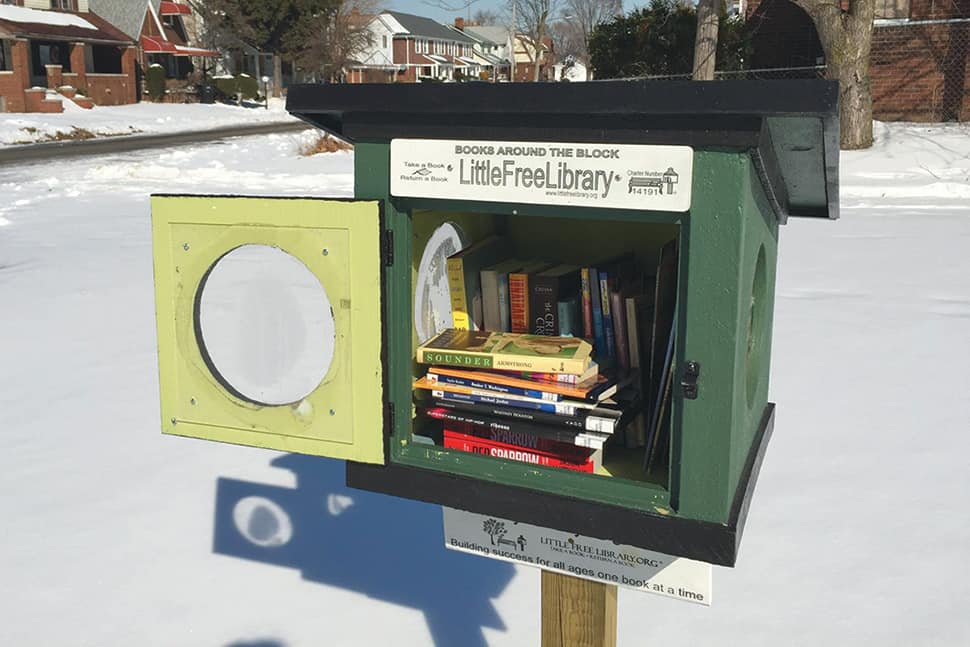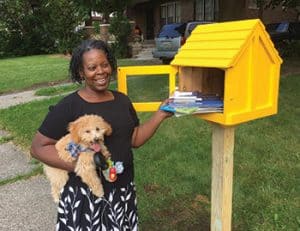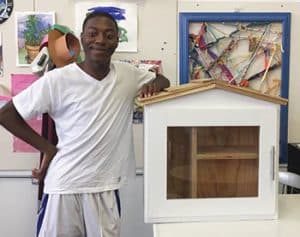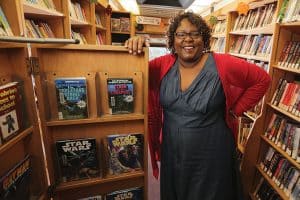
They have been popping up in droves. On front lawns and street corners. In parks, community centers, and hospitals. You can even find them at beaches, malls, and barbershops. What started in 2009 with a box on one man’s lawn has spawned 60,000 Little Free Libraries around the globe. The ubiquitous book-exchange boxes now outnumber public library branches in the US about three to one.
But are these seemingly wholesome book boxes helping or hurting staffed libraries? And how are librarians and communities across the country leveraging the presence of these outposts?
Little Free Library Capital of the World
When Pam Weinstein first noticed the school bus parked outside her home in Detroit’s Rosedale Park neighborhood and her lawn crowded with children, she thought there was some mistake. “Did the bus stop get moved?” she wondered.
But the kids were gathered around a wooden box planted in Weinstein’s front yard—a Little Free Library—while the bus driver helped each child pick out a title to take home. It was a ritual they repeated every Friday for almost year.
“They could clean it out in one visit, so I started putting more children’s books in there,” says Weinstein, whose book-exchange box was installed as part of a project to plant 313 of them around the city, effectively making Detroit the Little Free Library capital of the world.

Despite numerous articles and press releases announcing its renaissance and rebirth, Detroit is still a city that struggles with poverty, with more than 35% of its residents living below the poverty line in 2016. A recent New York University Steinhardt School of Culture, Education, and Human Development study showed that in many parts of the Detroit area, books are scarce. In Hamtramck, a small city bordering Detroit, for example, there is as few as one book for every 42 children.
As a reporter for the Detroit News for 25 years, Kim Kozlowski has seen the city through some difficult times, including when FBI homicide statistics prompted media outlets to crown it as the “murder capital of the US” in 2014. That same year, she noticed a Little Free Library pop up in her own suburban neighborhood and how it created community connections among residents there.
“The city had just climbed out of bankruptcy, and there was this sense of hope and excitement. People were banding together to do what they could to raise the city up. I thought I would start raising money to buy these Little Free Libraries, and it grew from there,” says Kozlowski, who would go on to head the nonprofit Detroit Little Libraries campaign.
Three years later, Kozlowski estimates there are about 500 Little Free Libraries in the city, including 97 that have been placed in front of Detroit public schools. Recently, Detroit Little Libraries and the national Little Free Library nonprofit announced a new initiative to put a Little Free Library in front of every police precinct in Detroit.
Media coverage of Detroit Little Libraries has been positive, with reports that they encourage literacy and replenish “book deserts.” But a study released last year questions that assumption. Jane Schmidt, librarian at Ryerson University in Toronto, noticed these fawning claims and was skeptical.
“They were using these warm and fuzzy words like ‘community building’ to describe these little boxes, while most of the media coverage about actual libraries is saying, ‘Who needs libraries anymore? Is the public library still relevant?’” says Schmidt.
So Schmidt joined with human geographer and librarian Jordan Hale of the University of Toronto to study Little Free Libraries, including mapping Toronto’s book boxes in relation to public library branch locations. The geographical analysis of Toronto’s Little Free Libraries confirmed their suspicions: the city’s book-exchange boxes didn’t water so-called “book deserts” but instead existed in affluent areas with easy access to public library branches.
Schmidt says no one denies these tiny book repositories are adorable, but what they actually do for literacy is unclear.
“It’s a lovely concept, it really is,” says Schmidt. “But when we think about the people who are fawning over them, are they people who are actually relying on the public library for their information needs?”
She adds, “Public libraries are serious business and lifelines for a lot of underserved communities.”
Harnessing the phenomenon
Detroit’s Little Free Libraries are standalone entities run by individual volunteers, but many public libraries across the US have gotten into the Little Free Library business themselves.
Friends of the Bismarck (N.Dak.) Public Library secured funding to purchase 13 Little Free Libraries to spread throughout the city. Instead of waiting for residents to install their own, the library took applications from patrons who wanted to be caretakers and chose them based on location to ensure the book exchanges would blanket the area.
BPL Director Christine Kujawa says community caretakers were allowed to personalize their libraries; some simply stained the wood box, while others painted them with intricate designs. Overall, she says, the project has been incredibly successful.
“Citizens continually ask us if the Friends of the Bismarck Public Library will do this again, and if so, can they put their name in now so they’re on the list of applicants,” says Kujawa. “People are starting to create their own Little Free Libraries from repurposed material, such as used newspaper racks.”
Kujawa says she sees Little Free Libraries as a way to complement and expand existing library offerings, such as the library’s bookmobile, which services the largely rural Burleigh County where Bismarck is located. Kujawa says the library has chosen six more spots to install Little Free Libraries in the area.
“This will allow rural citizens to have free access to reading material in between the bookmobile visits,” says Kujawa.
Salina (Kans.) Public Library embarked on a similar endeavor, building nine Little Free Libraries for the city’s nearly 50,000 residents. The public library built the boxes with money from a large donation bequeathed by a patron who passed away suddenly and thought it was a great way to honor his memory. One box that was made to resemble a rocket—cylindrical with a pointy top, the clear glass hatch door providing access to a shelf full of books—was placed in a park named after one of Salina’s most famous residents, former NASA astronaut Steve Hawley.
Lori Berezovsky, community engagement coordinator for Salina Public Library, says soon after the book exchanges were built, stocking and checking on them became a lot of work. The library put out some ads asking for residents to adopt a Little Free Library and care for it for a year, and decided to give volunteers access to donations and discarded library books to keep them stocked.
“It’s increased the number of volunteers and given them some ownership,” says Berezovsky. “I’ve realized the neighbors are paying attention and keeping an eye on them, too.”
For some folks, says Berezovsky, Little Free Libraries have become a family bonding activity. She says a dad and his daughter who has developmental disabilities ride their bikes to a certain Little Free Library once a week; they find a book to borrow and bring along one to contribute. There is also a mother–daughter duo who scours garage sales for books to donate. When they noticed that children’s books disappear particularly quickly, they began focusing on finding more.
“Kids who can’t drive, they don’t have a means to get to the library unless an adult brings them,” says Berezovsky. “If they can get some books that are of interest to them, that’s a great thing.”
Complement or competitor?
Back in 2009, Todd Bol built a little wooden schoolhouse, filled it with books and installed it on his front lawn as a tribute to his late mother. Today, Bol is the founder and executive director of the nonprofit Little Free Library. He says there are more than 60,000 Little Free Libraries registered worldwide—up from 50,000 last year—with 90% of them located in the United States.
One criticism researchers Hale and Schmidt, among others, have of Little Free Library is the nonprofit’s charge to use the Little Free Library name. The nonprofit charges $39 to register and use the name, and a few hundred bucks for the average prebuilt book-exchange box. Hale and Schmidt have questioned the need for a registration fee and branded name.

“You get a charter number. They put you on a map. You get some pamphlets and a sticker. Why does that come at such a substantial cost?” says Hale. “It could be very free and very grassroots and lovely.”
“Where is the money going? Is it going to literacy?” asks Hale. “The website says they build hundreds of installations in underserved communities, but where are those exactly, and were they funded by donations or charter fees?”
Bol says he appreciates the constructive criticism from Hale and Schmidt and hopes their questions can spur the nonprofit to refine its mission.
“We’re trying to do a better job of making transparent the work we do behind the scenes to fulfill that mission and to increase book access,” says Bol, who points to its Impact Library Program, which aims to provide 50 book exchanges to underserved communities this year.
“We are sometimes perceived to be a big institution, but we’re actually a small nonprofit—just 12 people in a Wisconsin office. We’re not ‘big’ Little Free Library,” says Bol.
And, he says, more than 600 public libraries around the country use Little Free Libraries as an extension of their services.
“Little libraries obviously cannot provide the depth and breadth of services that public libraries provide,” says Bol. “They can, however, act as natural complements to the public library, providing easy access to books to residents of neighborhoods or small towns that are far away from public library resources.”
But Hale and Schmidt point to at least one place where Little Free Libraries are seen as a substitute for true public library services. When budget cuts caused the El Paso (Tex.) Public Library to implement a $50 annual fee for nonresidents to use the library system, the tiny town of nearby Vinton came up with a plan: five Little Free Libraries spread around the community. The town would build them, and keeping them stocked with books would be up to the people of Vinton themselves.
When Detroit Public Library (DPL) closed its Gabriel Richard branch in 2011, 4th graders at a local elementary school installed a colorful painted bookcase and a sign reading “Outdoor Library” in front of the shuttered building. It was one of four libraries to close that year—two have since reopened, though only two to three days a week.
Despite budget shortfalls that led to reduced hours or staff cutbacks at other branches, DPL was recently able to restore Sunday hours at its main library, which hasn’t been possible since 1981, and it has brought back Sunday hours to two of its branches.
Although Little Free Libraries can provide access to books when hours are reduced or branches aren’t nearby, the quality of the books inside is often poor, says Mary-Catherine Harrison, professor of English at University of Detroit Mercy, who runs the nonprofit Rx for Reading Detroit.
“Often with Little Free Libraries, you get a lot of books people just want to get rid of. They’re not books that are adding value,” says Harrison. “That’s a real difference from libraries—you have children’s librarians who are acting as that resource, recommending books, making displays of books, choosing the best books.”
Harrison’s nonprofit also focuses on expanding access to print materials for Detroit kids, but in a different way. Rx for Reading creates caches of children’s books inside Detroit’s community centers and institutions, like WIC clinics, legal aid offices, soup kitchens, and homeless shelters. When families use these existing resources, kids get to take a book to keep. Rx for Reading both fundraises to buy books and takes donations, although Harrison says they’re thoughtful about which books they give away, and they refurbish books to make sure they don’t look like somebody’s castoffs.

Harrison says she does support the Little Free Library effort and that public libraries have their own barriers when it comes to low-income residents accessing resources. In the DPL system, she says, approximately 56,000 patrons—about 14%—are blocked from borrowing materials and using public computers because they have incurred more than $10 in fines. Harrison says she’d like to see more amnesty policies at public libraries across the US to allow broader access to services.
At least a few DPL librarians are taking advantage of Little Free Library locations to further their mission. Barbara Parker-Hawkins, manager and children’s librarian at DPL’s Chaney branch, keeps a box of books in her storeroom to give to kids to keep in situations where they can’t borrow books.
“When I run into a situation where the child might not be in a stable home environment, I tend to just give them a book so they have something to read,” she says.
Parker-Hawkins sees Little Free Libraries as an extension of that box in her storeroom. When it came time to weed through Chaney’s children’s collection and make room for new books, she boxed up her favorite titles and called Weinstein, the steward of the neighborhood’s Little Free Library.
Despite budget cuts and branch closings in recent years, Parker-Hawkins doesn’t feel any animosity toward these ubiquitous book boxes, even though they don’t offer the multitude of services real libraries provide.
“I think anything where you have a book is a library. The more we have out there, the better,” she says. “I don’t think we’re going to put the library out of business by any means. I see them as helping out the libraries. I’m very glad they’ve come along.”
Update: Corrected to indicate that Kim Kozlowski does not report for the Detroit Free Press, January, 1, 2018.


